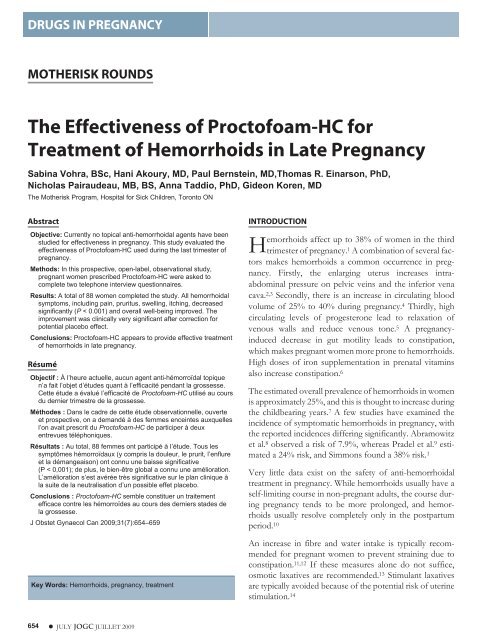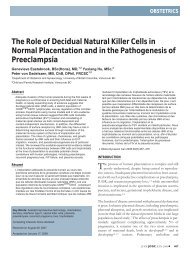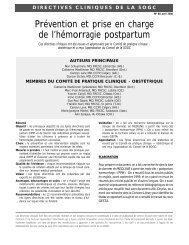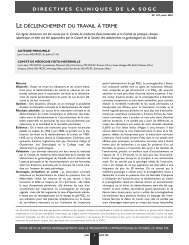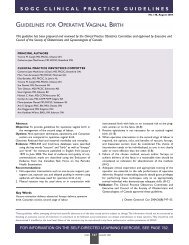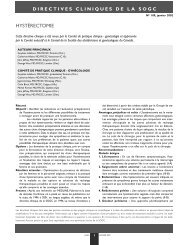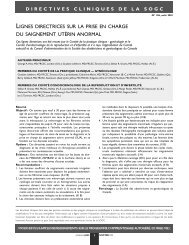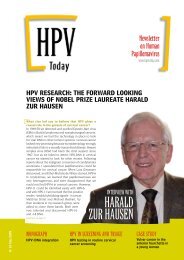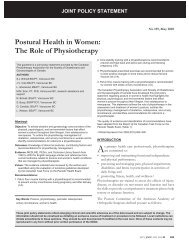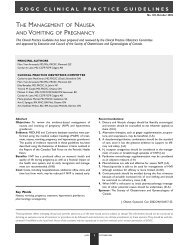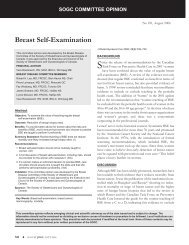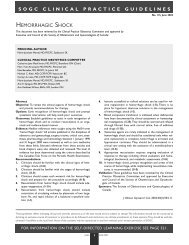JOGC-July 09.vp - SOGC
JOGC-July 09.vp - SOGC
JOGC-July 09.vp - SOGC
You also want an ePaper? Increase the reach of your titles
YUMPU automatically turns print PDFs into web optimized ePapers that Google loves.
DRUGS IN PREGNANCY<br />
MOTHERISK ROUNDS<br />
DRUGS IN PREGNANCY<br />
The Effectiveness of Proctofoam-HC for<br />
Treatment of Hemorrhoids in Late Pregnancy<br />
Sabina Vohra, BSc, Hani Akoury, MD, Paul Bernstein, MD,Thomas R. Einarson, PhD,<br />
Nicholas Pairaudeau, MB, BS, Anna Taddio, PhD, Gideon Koren, MD<br />
The Motherisk Program, Hospital for Sick Children, Toronto ON<br />
Abstract<br />
Objective: Currently no topical anti-hemorrhoidal agents have been<br />
studied for effectiveness in pregnancy. This study evaluated the<br />
effectiveness of Proctofoam-HC used during the last trimester of<br />
pregnancy.<br />
Methods: In this prospective, open-label, observational study,<br />
pregnant women prescribed Proctofoam-HC were asked to<br />
complete two telephone interview questionnaires.<br />
Results: A total of 88 women completed the study. All hemorrhoidal<br />
symptoms, including pain, pruritus, swelling, itching, decreased<br />
significantly (P < 0.001) and overall well-being improved. The<br />
improvement was clinically very significant after correction for<br />
potential placebo effect.<br />
Conclusions: Proctofoam-HC appears to provide effective treatment<br />
of hemorrhoids in late pregnancy.<br />
Résumé<br />
Objectif : À l’heure actuelle, aucun agent anti-hémorroïdal topique<br />
n’a fait l’objet d’études quant à l’efficacité pendant la grossesse.<br />
Cette étude a évalué l’efficacité de Proctofoam-HC utilisé au cours<br />
du dernier trimestre de la grossesse.<br />
Méthodes : Dans le cadre de cette étude observationnelle, ouverte<br />
et prospective, on a demandé à des femmes enceintes auxquelles<br />
l’on avait prescrit du Proctofoam-HC de participer à deux<br />
entrevues téléphoniques.<br />
Résultats : Au total, 88 femmes ont participé à l’étude. Tous les<br />
symptômes hémorroïdaux (y compris la douleur, le prurit, l’enflure<br />
et la démangeaison) ont connu une baisse significative<br />
(P < 0,001); de plus, le bien-être global a connu une amélioration.<br />
L’amélioration s’est avérée très significative sur le plan clinique à<br />
la suite de la neutralisation d’un possible effet placebo.<br />
Conclusions : Proctofoam-HC semble constituer un traitement<br />
efficace contre les hémorroïdes au cours des derniers stades de<br />
la grossesse.<br />
J Obstet Gynaecol Can 2009;31(7):654–659<br />
Key Words: Hemorrhoids, pregnancy, treatment<br />
654 JULY <strong>JOGC</strong> JUILLET 2009<br />
INTRODUCTION<br />
Hemorrhoids affect up to 38% of women in the third<br />
trimester of pregnancy. 1 A combination of several factors<br />
makes hemorrhoids a common occurrence in pregnancy.<br />
Firstly, the enlarging uterus increases intraabdominal<br />
pressure on pelvic veins and the inferior vena<br />
cava. 2,3 Secondly, there is an increase in circulating blood<br />
volume of 25% to 40% during pregnancy. 4 Thirdly, high<br />
circulating levels of progesterone lead to relaxation of<br />
venous walls and reduce venous tone. 5 A pregnancyinduced<br />
decrease in gut motility leads to constipation,<br />
which makes pregnant women more prone to hemorrhoids.<br />
High doses of iron supplementation in prenatal vitamins<br />
also increase constipation. 6<br />
The estimated overall prevalence of hemorrhoids in women<br />
is approximately 25%, and this is thought to increase during<br />
the childbearing years. 7 A few studies have examined the<br />
incidence of symptomatic hemorrhoids in pregnancy, with<br />
the reported incidences differing significantly. Abramowitz<br />
et al. 8 observed a risk of 7.9%, whereas Pradel et al. 9 estimated<br />
a 24% risk, and Simmons found a 38% risk. 1<br />
Very little data exist on the safety of anti-hemorrhoidal<br />
treatment in pregnancy. While hemorrhoids usually have a<br />
self-limiting course in non-pregnant adults, the course during<br />
pregnancy tends to be more prolonged, and hemorrhoids<br />
usually resolve completely only in the postpartum<br />
period. 10<br />
An increase in fibre and water intake is typically recommended<br />
for pregnant women to prevent straining due to<br />
constipation. 11,12 If these measures alone do not suffice,<br />
osmotic laxatives are recommended. 13 Stimulant laxatives<br />
are typically avoided because of the potential risk of uterine<br />
stimulation. 14
To date, there have been no studies on the effectiveness of<br />
topical agents in the treatment of hemorrhoids in pregnancy.<br />
Proctofoam-HC is a mucoadhesive foam consisting<br />
of a combination of pramoxine hydrochloride 1% and<br />
hydrocortisone acetate 1% and is intended for both internal<br />
and external anorectal use. Some studies have shown the<br />
usefulness of pramoxine to treat itching associated with<br />
psoriasis and pruritus ani in non-pregnant patients. 15–17 A<br />
double-blind placebo-controlled study showed a significant<br />
decrease in duration and magnitude of experimental<br />
histamine-induced pruritus. 17<br />
No studies have evaluated the efficacy of hydrocortisone<br />
acetate to alleviate any hemorrhoidal symptoms in pregnancy.<br />
Hydrocortisone has been shown to relieve itching<br />
associated with pruritus ani in non-pregnant adults; one<br />
study showed a 68% decrease in anal itch with the use of<br />
topical 1% hydrocortisone compared with placebo. 18<br />
Hydrocortisone has also been shown to decrease other<br />
anorectal conditions in the general population, such as pain,<br />
bleeding, and pruritus associated with anal fissures. 19<br />
Given the protracted course of hemorrhoids during pregnancy<br />
because of the persistence of the physiological<br />
changes inducing the symptomatology, it is essential to evaluate<br />
whether agents such as Proctofoam-HC may be effective<br />
during pregnancy. The objective of the present study<br />
was to evaluate the effectiveness of Proctofoam-HC in<br />
relieving hemorrhoid symptoms during the third trimester<br />
of pregnancy.<br />
MATERIALS AND METHODS<br />
We conducted a single-arm, prospective, observational<br />
study in pregnant women receiving Proctofoam-HC for<br />
hemorrhoids from their physicians. Each Proctofoam-HC<br />
aerosol container provides approximately 36 metered doses<br />
of pramoxine hydrochloride 1% and hydrocortisone acetate<br />
1% as a mucoadhesive foam.<br />
There is currently no validated tool to measure effectiveness<br />
of any anti-hemorrhoidal treatment. To overcome this<br />
barrier, we developed an effectiveness of treatment measurement<br />
scale (Appendix). This scale is a short, six-item<br />
questionnaire covering the five major symptoms of hemorrhoids:<br />
pain, itching, bleeding, swelling, and discomfort, as<br />
well as the overall effect of hemorrhoids on well-being. Participants<br />
were asked to score each symptom on a scale from<br />
0 to 10, where 0 indicates none and 10 indicates maximum.<br />
This questionnaire was completed twice, once prior to use<br />
of Proctofoam-HC and again after treatment of at least two<br />
weeks’ duration. At the time of completion of the second<br />
questionnaire, the participants were asked an additional single<br />
question regarding their overall improvement on<br />
The Effectiveness of Proctofoam-HC for Treatment of Hemorrhoids in Late Pregnancy<br />
Proctofoam-HC treatment, with 0 indicating no<br />
improvement and 10 indicating maximum improvement.<br />
If the subject delivered less than two weeks after the first<br />
questionnaire was completed, the second questionnaire was<br />
completed postpartum.<br />
The primary outcome of the study was pain, as it is a fairly<br />
common complaint among patients with hemorrhoids. 10<br />
Secondary outcomes included all other hemorrhoidal<br />
symptoms, such as pruritus ani, discomfort, and anal swelling,<br />
as well as improvement in well-being and global<br />
improvement scores.<br />
Symptom severity before and after treatment was compared<br />
using Student t test if the data were normally distributed, or<br />
Wilcoxon signed rank test if the data were not normally distributed.<br />
SigmaStat version 3.11.0 (Systat Software Inc,<br />
Point Richmond, CA) was used for the statistical analysis.<br />
The study protocol was approved by the research ethics<br />
boards at the Hospital for Sick Children, North York General<br />
Hospital and Sunnybrook Health Sciences Centre.<br />
Study subjects gave verbal consent to participate.<br />
RESULTS<br />
A total of 88 women completed the effectiveness study.<br />
Their mean age was 32.9 years (median 33), and median<br />
gravidity was 2 and median parity 1. At baseline, almost all<br />
of the participants complained of hemorrhoidal swelling<br />
(99%) and anal discomfort (98%). Anal or rectal pain was<br />
noted by 90% of the women, and rectal bleeding was present<br />
in one half of the participants (53%). Almost all of the<br />
women (97%) reported that the hemorrhoids negatively<br />
affected their well-being.<br />
Following the use of Proctofoam-HC, subjects reported a<br />
mean 73% decrease in pain (4.3 points, P < 0.001). A similar,<br />
significant decrease was seen in all secondary outcomes:<br />
itching (73%, P < 0.001), swelling (60%, P < 0.001), bleeding<br />
(74%, P < 0.001), and discomfort (77%, P < 0.001)<br />
(Table). Participants also reported significant improvement<br />
in their overall well-being (74%, P < 0.001) (Table). The<br />
above results are presented graphically in Figure 1. The<br />
mean score for global improvement with treatment was<br />
7.6 ± 2.3 (range 0–10). Only one participant reported no<br />
improvement with treatment (score of 0), and another two<br />
experienced minimal improvement (scores of 1 and 2).<br />
Almost two thirds of the participants (62%) rated improvement<br />
as 8 or greater, and 29% (n = 26) reported the maximum<br />
possible improvement (score of 10).<br />
JULY <strong>JOGC</strong> JUILLET 2009 655
DRUGS IN PREGNANCY<br />
Details on the changes in anorectal scores following local treatment with Proctofoam-HC<br />
Symptom n<br />
DISCUSSION<br />
With the effect size shown, 23 patients were required to<br />
detect a clinically significant decrease in the primary outcome<br />
of pain.<br />
Several efficacy studies on oral and local preparations for<br />
the treatment of symptomatic hemorrhoids used a<br />
four-point scoring scale, 20–23 while others used a Likert-type<br />
scale that included two or three options. 24–26 and a few studies<br />
used a combination of the two. 27,28 However, we felt that<br />
none of these scales was sufficiently detailed to measure the<br />
continuity of given symptoms quantitatively and qualitatively,<br />
and they tended not to include all major symptoms of<br />
hemorrhoidal disease. The effectiveness of treatment measurement<br />
scale used in the present study consisted of an<br />
11-point range, which we felt was better able to detect<br />
smaller changes in symptoms. The scale included assessment<br />
of all of the major symptoms of hemorrhoids: pain,<br />
swelling, bleeding, itching, and discomfort. To help us<br />
better understand changes in the patient’s quality of life, we<br />
also included questions about changes in well-being.<br />
Finally, global improvement scores were included in the<br />
scale questionnaire. Because of this greater detail, we concluded<br />
that our effectiveness of treatment measurement<br />
scale (Appendix) was more likely to detect effectiveness of<br />
treatment than previous scales; however, this scale has not<br />
been fully validated externally, although this process is<br />
under way.<br />
In the present study, local treatment with Proctofoam-HC<br />
was found to be very effective in reducing all symptoms<br />
related to hemorrhoids. A significant decrease in the primary<br />
outcome (pain) was noted. In previous studies, a<br />
decrease of 2 points from baseline on the 11-point pain<br />
intensity numerical rating scale has been considered to be<br />
clinically significant. 29 In the present study, the decrease in<br />
pain reported was twice as large, with a decrease of 4.3<br />
points from baseline. One study found that patients only<br />
considered a 50% improvement in pain as a treatment<br />
656 JULY <strong>JOGC</strong> JUILLET 2009<br />
Before treatment<br />
(SD)<br />
After treatment<br />
(SD)<br />
Mean decrease in<br />
score (SD) % decrease P*<br />
Pain 79 6.4 (2.4) 1.7 (2.1) 4.3 (2.6) 73.4 0.001<br />
Itching 66 4.9 (2.2) 1.3 (1.9) 3.3 (2.3) 73.5 0.001<br />
Swelling 87 6.8 (2.4) 2.7 (2.7) 3.8 (2.9) 60.3 0.001<br />
Bleeding 47 3.9 (3.0) 1.0 (1.4) 2.9 (2.7) 74.4 0.001<br />
Discomfort 86 6.9 (2.6) 1.6 (2.2) 5.1 (3.0) 76.8 0.001<br />
Well-being 85 6.5 (2.6) 1.7 (2.1) 4.5 (3.0) 73.8 0.001<br />
Scores ranked on an 11-point numerical scale where 0 indicates no pain and 10 indicates maximum pain.<br />
*Wilcoxon signed rank test<br />
success. 30 The 73.4% decrease in pain observed in this study<br />
could therefore be interpreted as showing a high level of<br />
success in treating hemorrhoids during pregnancy.<br />
A significant decrease of 73% to 77% in itching, swelling,<br />
discomfort, and bleeding was also noted post treatment.<br />
These results are corroborated by the reported 74%<br />
increase in overall well-being after treatment. The primary<br />
goal of effective antihemorrhoidal treatment in pregnancy is<br />
to improve well-being, and thus quality of life, which these<br />
results clearly demonstrate.<br />
At the end of the second questionnaire, women were asked<br />
a single question regarding the overall magnitude of<br />
improvement with the treatment. The mean response by<br />
the participants was 7.6 ± 2.3 (range 0–10), with a median<br />
response of 8. Previous epidemiological studies have<br />
reported that 10% to 20% of patients have persistent symptomatic<br />
hemorrhoids requiring surgery. 31 Based on this statistic,<br />
we expected that between nine and 18 women in the<br />
study sample would have persistent hemorrhoids that<br />
would not heal. The numbers observed in the study were at<br />
the lower end of that range, which is reassuring.<br />
A major limitation of the present study was the lack of a placebo<br />
group. Since hemorrhoids in pregnancy are chronic in<br />
nature, the chance of spontaneous improvement before<br />
delivery is believed to be small, suggesting that the size of<br />
the effect observed in this study was probably a true measure<br />
of effectiveness and devoid of a significant placebo<br />
effect. Nonetheless, it is important to estimate the outcome<br />
if there was indeed a placebo effect. To that end, we<br />
reviewed the literature on interventional anti-hemorrhoidal<br />
trials with a placebo group. A total of 11 studies were identified.<br />
20–28,32,33 Of these, only two included pregnant<br />
women. 25,28 The duration of treatment in the nine studies of<br />
non-pregnant subjects ranged from seven days to two<br />
months. Symptoms of hemorrhoids in non-pregnant adults<br />
tend to be self-limiting and may subside without medication.<br />
34 In one study, 22 the mean healing time without
Figure 1. Change in hemorrhoidal symptoms with treatment<br />
Mean score<br />
8<br />
7<br />
6<br />
5<br />
4<br />
3<br />
2<br />
1<br />
0<br />
8<br />
7<br />
6<br />
5<br />
4<br />
3<br />
2<br />
1<br />
0<br />
*<br />
treatment was 5.6 days for anal bleeding and 6.5 days for<br />
pain. Other studies have shown remission of severely<br />
thrombosed hemorrhoids within 7 to 24 days. 10,35 It is possible<br />
that the beneficial effects of treatment in these studies<br />
in non-pregnant patients reflected a strong placebo effect,<br />
which we would expect to be less prevalent in pregnant<br />
women.<br />
In the studies involving pregnant women, subjects were<br />
randomized to receive oral rutosides or placebo, and the<br />
results of treatment were recorded after two weeks and<br />
again after four weeks. The first study 28 only included<br />
patients with grade 1 and grade 2 hemorrhoids. Grade 1 and<br />
2 hemorrhoids are typically associated with very mild symptoms<br />
and are often not diagnosed unless they worsen and<br />
present with bleeding and prolapse. Most first degree<br />
*<br />
*<br />
The Effectiveness of Proctofoam-HC for Treatment of Hemorrhoids in Late Pregnancy<br />
*<br />
Pain Itching Swelling Bleeding Discomfort Affect<br />
Wellbeing well-being<br />
Symptoms<br />
Symptom<br />
Before treatment Treatment After treatment<br />
Figure 2. Change in symptoms after adjusting for placebo effect<br />
Mean score<br />
*<br />
*<br />
*<br />
*<br />
*<br />
Pain Itching Swelling Bleeding Discomfort Affect Well-<br />
well-being being<br />
Symptoms<br />
baseline 13% placebo no placebo effect<br />
*<br />
*<br />
*<br />
*<br />
*<br />
*<br />
hemorrhoids are easily managed by lifestyle changes and<br />
resolve faster than more severe hemorrhoids. 10,35 Since significant<br />
swelling and bleeding was observed in the sample<br />
population in the effectiveness study, it is likely that a significant<br />
proportion had some degree of prolapse, and thus<br />
grade 3 and possibly grade 4 hemorrhoids. Hence, this first<br />
placebo controlled study in pregnancy 28 did not estimate<br />
the placebo effect appropriately for comparison with our<br />
study. The second study, by Wijayanegara and colleagues, 25<br />
observed a 12% and 14% improvement of their placebotreated<br />
pregnant patients at week two and week four,<br />
respectively. Most of the women included in the study had<br />
grade 2 or 3 hemorrhoids. Extrapolating this observed<br />
placebo effect, we conducted a secondary analysis after<br />
taking into consideration a potential 12% to 14% placebo<br />
*<br />
*<br />
*<br />
JULY <strong>JOGC</strong> JUILLET 2009 657
DRUGS IN PREGNANCY<br />
effect. Since subjects in the Wijayanegara et al. study did not<br />
use a symptom scoring scale, the average of the total<br />
improvement (13%) was subtracted from every symptom in<br />
our effectiveness study. After analysis with the Wilcoxon<br />
signed rank test, a highly significant decrease in all hemorrhoidal<br />
symptoms (P < 0.001) was still observed (Figure 2).<br />
These results further suggest that Proctofoam-HC enabled<br />
significant global improvement, and was highly effective in<br />
treating hemorrhoidal symptoms in the majority of the<br />
pregnant patients. Nevertheless, more studies of other<br />
anti-hemorrhoidal agents in pregnancy are needed, as the<br />
pathophysiology of hemorrhoids during pregnancy does<br />
not allow the direct extrapolation of results obtained in<br />
non-pregnant patients.<br />
ACKNOWLEDGEMENTS<br />
This study was supported by unrestricted grants from<br />
Duchesnay Inc., Blainville Quebec, manufacturer of<br />
Proctofoam-HC. The study protocol was devised at the<br />
Motherisk Program. The funding source had no involvement<br />
in the recruitment, collection of data, data analysis, or<br />
preparation of the manuscript.<br />
REFERENCES<br />
1. Simmons SC. Anorectal disorders in pregnancy. J Obstet Gynecol<br />
1964;71:960–2.<br />
2. Lurz KH, Göltner E. Hämorrhoiden in Schwanger-schaft und Wochenbett.<br />
MMW Munch Med Wochenschr 1977;119:1551.<br />
3. Parturier-Albot M, Rouzette P, Elizalde N. Hémorrhoides et vue génitale de<br />
la femme. Arch Fr Mal Appar Dig 1976; 65:537.<br />
4. Goodman M. Maternal adaptations in pregnancy. In: Johnson LR, Byrne JH,<br />
eds. Essential medical physiology. 3rd ed. New York: Academic Press;<br />
2003:953–67.<br />
5. Singer AJ, Brandt LJ. Pathophysiology of the gastrointestinal tract during<br />
pregnancy. Am J Gastroenterol 1991;86(12):1695–712.<br />
6. Bradley CS, Kennedy CM, Turcea AM, Rao SS, Nygaard IE. Constipation in<br />
pregnancy: prevalence, symptoms, and risk factors. Obstet Gynecol<br />
2007;110(6):1351–7.<br />
7. Hyams L, Philpot J. An epidemiological investigation of hemorrhoids. Am J<br />
Proctol 1970;21(3):177–93.<br />
8. Abramowitz L, Sobhani I, Benifla JL, Vuagnat A, Darai E, Mignon M, et al.<br />
Anal fissure and thrombosed external hemorrhoids before and after delivery.<br />
Dis Colon Rectum 2002;45:650–5.<br />
9. Pradel E, Terris G, Juilliard F, De la Lande PH, Chartier M. Grossesse et<br />
pathologie anale. Étude prospective. Méd Chir Dig 1983;12:523–5.<br />
10. Dykes S, Bordeianou L. Hemorrhoids and incontinence. In: Kovac SR,<br />
Zimmerman CW, eds. Advances in reconstructive vaginal surgery.<br />
Philadelphia: Lippincott Williams & Wilkins;2007:320–3.<br />
11. Jewell DJ, Young G. Interventions for treating constipation in pregnancy.<br />
Cochrane Database Syst Rev 2001;2:CD001142.<br />
12. Anderson AS, Whichelow MJ. Constipation during pregnancy: dietary fibre<br />
intake and the effect of fibre supplementation. Hum Nutr Appl Nutr<br />
1985;39:202–7.<br />
13. Tytgat GN, Heading RC, Müller-Lissner S, Kamm MA, Schölmerich J,<br />
Berstad A, et al. Contemporary understanding and management of reflux and<br />
658 JULY <strong>JOGC</strong> JUILLET 2009<br />
constipation in the general population and pregnancy: a consensus meeting.<br />
Aliment Pharmacol Ther 2003;18:291–301.<br />
14. Gilman AG, Rall TW, Nies AS. Goodman and Gilman’s the pharmacological<br />
basis of therapeutics. 8th ed. New York: Pergamon Press;1990.<br />
15. Dawn A, Yosipovitch G. Treating itch in psoriasis. Dermatol Nurs<br />
2006;18(3):227–33.<br />
16. Grove G, Zerweck C. An evaluation of the moisturizing and anti-itch effects<br />
of a lactic acid and pramoxine hydrochloride cream. Cutis 2004;73(2):135–9.<br />
17. Yosipovitch G, Maibach HI: Effect of topical pramoxine on experimentally<br />
induced pruritus in humans. J Am Acad Dermatol 1997;37:278.<br />
18. Ghnaniem R, Short K, Pullen A, Fuller LC, Rennie JA, Leather AJM. 1%<br />
Hydrocortisone ointment is an effective treatment of pruritus ani: a pilot<br />
randomized controlled crossover trial. Int J Colorectal Dis 2007;22:1463–7.<br />
19. Jensen SL. Treatment of first episodes of acute anal fissure: prospective<br />
randomized study of lignocaine ointment versus hydrocortisone ointment or<br />
warm water sitz baths plus bran. Br Med J 1986;292:1168–9<br />
20. Cospite M. Double-blind, placebo-controlled evaluation of clinical activity and<br />
safety of Daflon 500 mg in the treatment of acute hemorrhoids. Angiology<br />
1994;45:566–73.<br />
21. Clyne MB, Freeling P, Ginsborg S. Troxerutin in the treatment of<br />
haemorrhoids. Practitioner 1967;198:420–3.<br />
22. Chauvenet M, Libeskind M. Interest of hemisynthesis diosmin in the<br />
hemorrhoidal crisis: double blind randomized multicentric trial versus<br />
placebo. Rev Fr Gastroenterol 1994;30:642–7.<br />
23. Annoni F, Boccasanta P, Chiurazzi D, Mozzi E, Oberhauser V. Treatment of<br />
acute symptoms of hemorrhoid disease with high-dose oral<br />
O-(beta-hydroxyethyl)-rutosides. Minerva Med 1986;77:1663–8.<br />
24. Trochet JP. Multicentric study of Veinamitol procto 3500 mgTM in the<br />
treatment of acute hemorrhoid. Rev Fr Gastroenterol 1992;28:19–25.<br />
25. Wijayanegara H, Mose JC, Achmad L, Sobarna R, Permadi W. A clinical trial<br />
of hydroxyethylrutosides in the treatment of haemorrhoids of pregnancy.<br />
J Int Med Res 1992;20:54–60.<br />
26. Sinnatamby CS. The treatment of hemorrhoids. Role of<br />
hydroxyethylrutosides, troxerutin (Paroven; Varmoid; Venoruton). Clin Trials<br />
J 1973;2:45–50.<br />
27. Thanapongsathorn W, Vajrabukka T. Clinical trial of oral diosmin (Daflon) in<br />
the treatment of hemorrhoids. Dis Colon Rectum 1992;35:1085–8.<br />
28. Titapant V, Indrasukhsri B, Lekprasert V, Boonnuch W.<br />
Trihydroxyethylrutosides in the treatment of hemorrhoids of pregnancy:<br />
a double-blind placebo-controlled trial. J Med Assoc Thai 2001;84:1395–400.<br />
29. Farrar JT, Young JP Jr, LaMoreaux L, Werth JL, Poole RM. Clinical<br />
importance of changes in chronic pain intensity measured on an 11-point<br />
numerical pain rating scale. Pain 2001;94(2):149–58.<br />
30. Colvin DF, Bettinger R, Knapp R, Pawlicki R, Zimmerman J. Characteristics<br />
of patients with chronic pain. South Med J 1980;73:1020–3.<br />
31. Bleday R, Pena JP, Rothenberger DA, Goldberg SM, Buls JG. Symptomatic<br />
hemorrhoids: current incidence and complications of operative surgery. Dis<br />
Colon Rectum 1992;35:477–81.<br />
32. Godeberge P. Daflon 500 mg in the treatment of hemorrhoidal disease:<br />
a demonstrated efficacy in comparison with placebo. Angiology<br />
1994;45:574–8.<br />
33. Misra MC, Parshad R. Randomized clinical trial of micronized flavonoids in<br />
the early control of bleeding from acute internal haemorrhoids. Br J Surg<br />
2000;87:868–72.<br />
34. Barnes CL, Scates AC, Fine JS. Treatment of hemorrhoids. US Pharm<br />
2002;22:8.<br />
35. Cormon ML. Colon and rectal surgery. 5th ed. Philadelphia: Lippincott<br />
Williams & Wilkins;2005:128–247.
Appendix<br />
Hemorrhoid Survey Scale<br />
Please answer the following survey to the best of your<br />
knowledge. The first set of questions asks you about your<br />
health PRIOR to using Proctofoam-HC ® for the treatment<br />
of your hemorrhoids. The second set of questions asks you<br />
about your health AFTER the use of Proctofoam-HC ®.<br />
We would like to assess whether Proctofoam-HC ® provided<br />
any relief for your pregnancy related hemorrhoidal<br />
symptoms.<br />
Please answer each question with 0 being ‘none’ and<br />
10 being ‘maximum’.<br />
Prior to treatment with Proctofoam-HC®:<br />
How do you rate the pain you experienced?<br />
0 1 2 3 4 5 6 7 8 9 10<br />
How much itching did you have?<br />
0 1 2 3 4 5 6 7 8 9 10<br />
How much swelling was present?<br />
0 1 2 3 4 5 6 7 8 9 10<br />
How much bleeding did you experience?<br />
0 1 2 3 4 5 6 7 8 9 10<br />
How much discomfort did you experience?<br />
0 1 2 3 4 5 6 7 8 9 10<br />
The Effectiveness of Proctofoam-HC for Treatment of Hemorrhoids in Late Pregnancy<br />
How much did your hemorrhoids affect your well-being?<br />
0 1 2 3 4 5 6 7 8 9 10<br />
Post Treatment (with Proctofoam-HC®):<br />
How do you rate the pain you experienced?<br />
0 1 2 3 4 5 6 7 8 9 10<br />
How much itching did you have?<br />
0 1 2 3 4 5 6 7 8 9 10<br />
How much swelling was present?<br />
0 1 2 3 4 5 6 7 8 9 10<br />
How much bleeding did you experience?<br />
0 1 2 3 4 5 6 7 8 9 10<br />
How much discomfort did you experience?<br />
0 1 2 3 4 5 6 7 8 9 10<br />
How much did your hemorrhoids affect your well-being?<br />
0 1 2 3 4 5 6 7 8 9 10<br />
How would you rate the overall improvement? With 0<br />
being ‘no improvement’ and 10 being ‘maximum<br />
improvement’.<br />
0 1 2 3 4 5 6 7 8 9 10<br />
JULY <strong>JOGC</strong> JUILLET 2009 659


